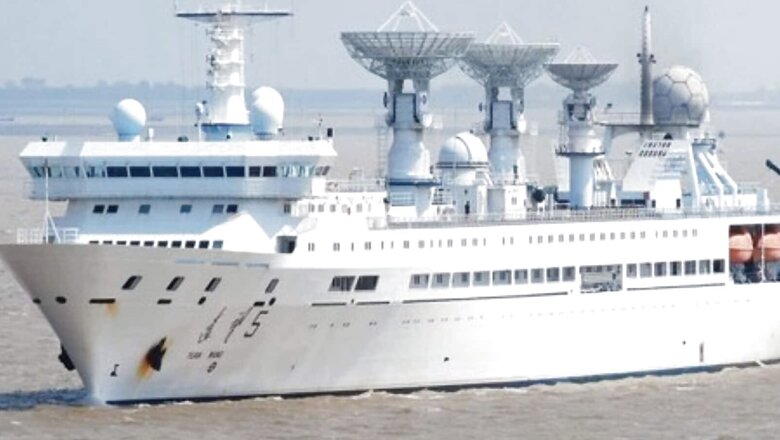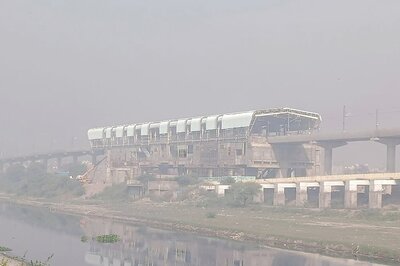
views
Narrative setting is an important component of strategy and international relations. This piece is regarding Chinese surveillance ship Yuan Wang 5 that was berthed at Sri Lanka’s Hambantota port. It was done at the behest of Beijing under the pretext of “replenishment of supplies and equipment”.
The issue has become a significant security concern for New Delhi. For, this dual-purpose spy ship is capable of monitoring space and satellites and launching intercontinental ballistic missiles. Yuan Wang 5 forms a part of China’s People’s Liberation Army Strategic Support Force (PLASSF). At a casual glance it appears like a civilian cruise vessel, but instead it is a vessel conducting strategic/military operations.
It is important to note that the Yuan Wang class is not a single class of identical design, different designs grouped under the same series that share the same name. This series of ships includes “space tracking ships involved in supporting the manned space programme”. Of particular concern is the Class 5 in the series named as Yuan Wang 5 (Long View). It is equipped with a high-tech tracking system that connects with the Chinese satellites which are then used for tracking intercontinental ballistic missiles and other military intelligence assets.
The Yuan Wang Class 5 ship houses three satellite dish antennas. It is designed to receive or transmit information by radio waves to or from a communication satellite. The utility of which is to convert microwave signals into electrical signals. The size of the device is inversely proportional to the frequency signal — i.e. lower the frequency, larger must be the dish antenna and higher frequency signals are captured by smaller dish antennas. In comparison, apart from China (Yuan Wang Class), the US (USNS Invincible [T-AGM-24] and USNS Observation Island [T-AGM-23]); Russia (Yantar class); France (Monge [A601] and India (INS Dhruv and INS Anvesh, reportedly under construction) possess such capabilities.
Along similar lines media reports indicate that the UK is also building a new spy ship to deal with an increasing threat from Russian and Chinese submarines. The Royal Navy vessel is being developed as part of a £24 billion upgrade and should be available by 2024. The multi-role ship will also feature underwater drones and mini-subs to help it seek out any threats, the report adds.
The Sri Lankan government under Ranil Wickremesinghe, despite deferring the visit of the spy vessel, came under direct pressure from none other than former Public Security Minister and ex-Navy Chief Rear Admiral Sarath Weerasekara, who openly questioned the move, according to reports in the media. Reports also add that Captain Zhang Hongwang of the Yuan Wang 5 snubbed Weerasekera by refusing to shake hands with him or permit him to get inside the ship. According to Captain Zhang Hongwang, the ship is on a “mission of peace and friendship” and its docking at the Sri Lankan port will deepen bilateral relations in the field of space, science and technology.
The Indian Ocean is the only ocean named after a country and India enjoys a geographic advantage of being placed at the head of the Indian Ocean. There are also sensitive military-cum-strategic installments in the peninsular region of India. China has always been wary and concerned about India’s advantage in the Indian Ocean Region (IOR), as most of the former’s supplies are routed through this region passing via the narrow Malacca Strait. In times of conflict, the Indian Navy can effectively make a blockade and initiate a ‘commerce raiding’. Today, Beijing enjoys a friendlier South Asia in the IOR maritime space than South East Asia and the Pacific Theatre where it faces stiff resistance from the US and Australia. Adding to China’s concern are its self-imposed conflicts in the South China Sea (Indo-China Sea) and tensions in East Asia.
Currently, Sri Lanka is reeling under severe economic pressure with red flags being raised as part of China’s ‘Debt Trap Diplomacy’. A 2021 report quoting the then Sri Lankan Foreign Minister, Dinesh Gunawardena, said that the controversial deal to take over the Hambantota port on a 99-year lease had a provision for extension for another 99 years. Although this was vehemently denied by the Chinese side, the truth remains elusive. Being a deep-water port, it will not be surprising to see in future China converting Hambantota into a military base to expand its long-term interests.
In terms of strategic signalling China has always been proactive. During 2014 elections in Sri Lanka, the then President, Mahinda Rajapaksa, called for an early election. During these times, China had sent a conventional diesel-powered submarine that berthed at the Colombo port from 7-13 September 2014 and another one from 31 October to 6 November 2014. The Chinese reasoned that the submarine was on an escort mission to the Gulf of Aden and waters off the Somali coast and had docked on for replenishment.
In January 2015, when Maithripala Sirisena was elected the new President of Sri Lanka, President Xi Jinping called his new Sri Lankan counterpart an “old friend”. This also paved the way for Sirisena to China. It was evident that China viewed Colombo as an important diplomatic partner in South Asia.
Again, during the time of the 2022 Australian elections, China dispatched its intelligence ship which was tracked off Australia’s west coast within 50 nautical miles as it sailed past the Harold E Holt naval communications station at Exmouth, in Western Australia, which is used by Australian, US and allied submarines. The election results showed a political change in Australia. The patterns that emerge seemingly indicate the emergence of Chinese spy ships especially during crucial political changes. There is also a visible pressure on India and a demand for greater study to know if any crucial intelligence was collected by China in all such occurrences.
As part of India’s neighbourhood-first policy, New Delhi has extended a loan to Sri Lanka to the tune of $1.9 billion; assistance worth $2.5 billion of food and fuel; supplied 270,000 metric tonnes of diesel and petrol; additional 40,000 tonnes of rice in view of Sinhala and Tamil New Year festivities in the middle of the crisis. India’s RBI has extended a currency swap of $400 million and went far to defer payments owned by the Central Bank of Sri Lanka under SAARC Currency Swap Framework. In addition, vegetables and medicines, including daily rations, were sent as aid which was acknowledged by Sri Lankan President Ranil Wickremesinghe in the parliament. He said, “The Government of India under the leadership of Prime Minister Modi has given us a breath of life. On behalf of my people and that of my own, I convey our gratitude to Prime Minister Modi, the Government and people of India.”
To conclude, two strategic factors must tailor India’s regional response. First, it must sustain the new economic growth trajectory, which is imperative to ensure that regional instability does not hamper India’s growth trajectory. Second, China’s growing footprints must be in foresight of India’s regional strategic calculus. At a time when China’s premeditated military moves along our northern boundary are drawing the nation’s attention, it is important that we don’t lose sight of our surrounding seas and maritime environment. Given the complexities of the post-Covid world order, India’s diplomacy and role of the Indian Navy in the Indian Ocean Region will define New Delhi’s position in the new world order.
The author is a Chennai based analyst. The views expressed in this article are those of the author and do not represent the stand of this publication.
Read all the Latest Opinion News and Breaking News here


















Comments
0 comment